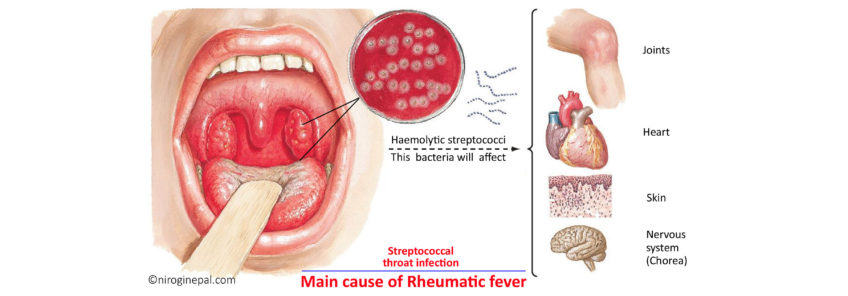
- Young age (5-15 years of age)
- Overcrowding and poor sanitation
- Lack of access to medical services
- Family history
- Poverty and malnutrition
- Fever (generally high grade)
- Chest pain (mostly while breathing)
- Palpitation (feeling of your own heart beat)
- Lethargy or fatigue
- Shortness of breath
- Swelling of limbs
- Pain and swelling in joints in the wrists, elbows, knees and ankles
- Pain in one joint that moves to another joint
- Small painless nodules under the skin (subcutaneous nodules)
- Involuntary and uncontrollable jerky (dancing) movements of hands, feet and face (Sydenham chorea)
- Painless, flat rashes with ragged edges known as erythema marginatum
- Throat swabs to grow streptococci causing sore throat/pharyngitis
- Blood testing for looking for evidence of recent streptococcal infection. (ASO and anti DNAse level)
- ECG to observe the electrical activity of heart
- Chest X ray to see enlargement of heart and evidence of heart failure
- Echocardiogram to evaluate the damage to the heart valves
- Symptomatic treatment
- Eradication of streptococcal infection (strep throat) and
- Prophylaxis against future recurrence and to prevent progression of cardiac disease
- Anti – inflammatory agents (Aspirin, NSAIDS, low dose glucocorticoids) are the mainstay of symptomatic treatment of Acute rheumatic fever. It reduces fever, alleviates symptoms of inflammation in joints and heart. Patients with severe damage to the heart may need treatment of congestive heart failure (CHF) with diuretics, angiotensin-converting enzyme (ACE) inhibitors and digoxin.
- Antibiotics (oral – Penicillin V or Amoxicillin or IM Benzathine Penicillin) are used to treat strep throat. Adequate and appropriate antibiotics treatment reduces the risk of getting rheumatic fever
- Penicillin (Benzathine Penicillin G) is the preferred choice for long term prophylaxis to prevent recurrence and to prevent progression of the cardiac disease
Rheumatic fever is a systemic illness which can occur after a throat infection with a bacteria called Streptococcus pyogenes. It’s serious illness that can cause permanent damage to the heart. Rheumatic fever is common in underdeveloped countries like Nepal. It is most common in children (5 to 15 years old) but can occur in younger children and adults as well.
Causes
Rheumatic fever usually follows a throat infection caused by a specific group of bacteria called Group A Streptococcus. The exact association between strep infection and rheumatic fever is not clear but it’s thought to be immune mediated. The streptococcal bacteria contains a protein similar to the one found in the certain tissues of the body mainly heart, joints, skin and central nervous system. Strep throat, if not treated on time or inadequately treated, the immune system cells that would normally target the bacteria; may also target the these tissues resulting in inflammation of those tissues. Rheumatic fever symptoms are mainly from the inflammation of those affected tissues.
Rheumatic fever does not affect all individuals who have had a strep throat infection.
The risk factors for rheumatic fever include:
Symptoms
The symptoms of the disease may vary from person to person. Some may experience a wide range of symptoms whereas some may only get a few. The symptoms usually occur about 2 to 4 weeks after the onset of strep throat infection.
The symptoms are seen from inflammation in the heart, joints, central nervous system and skin:
Diagnosis
You should see your doctor if your child has signs and symptoms of a throat infection. You should immediately see a doctor if your child shows signs or symptoms of rheumatic fever. Diagnosis is usually based on the presence of signs and symptoms in combination with evidence of a recent streptococcal infection using the Jones criteria.
Your doctor will advise you to undergo some tests like to look for causes, make the diagnosis and detect complications:
Treatment
The main goals of the treatment are:
Bed rest is enforced even if the patient feels well enough. Regular activity should not be resumed till inflammation has subsided.
Diazepam or anticonvulsant medications (valproic acid, carbamazepine) is given for chorea (abnormal jerky movements of hand, feet or face)
Prevention
Primary Prevention:
Primary prevention means prevention of development of rheumatic fever after a throat infection. Proper diagnosis and adequate antibiotics treatment of strep throat can prevent acute rheumatic fever in most cases.
Secondary Prevention:
Secondary prevention means prevention of recurrent rheumatic fever after successful treatment of first episode of rheumatic fever. A child who has had attack of rheumatic fever is at very high risk of developing recurrence after subsequent strep throat infection and needs continuous antibiotics prophylaxis to prevent such recurrences. In general continuous antibiotics are needed upto age of 25 years. If there is permanent significant damage to the heart valves , antibiotics are needed for longer duration and possibly for life long.



Send us your feedback on this article